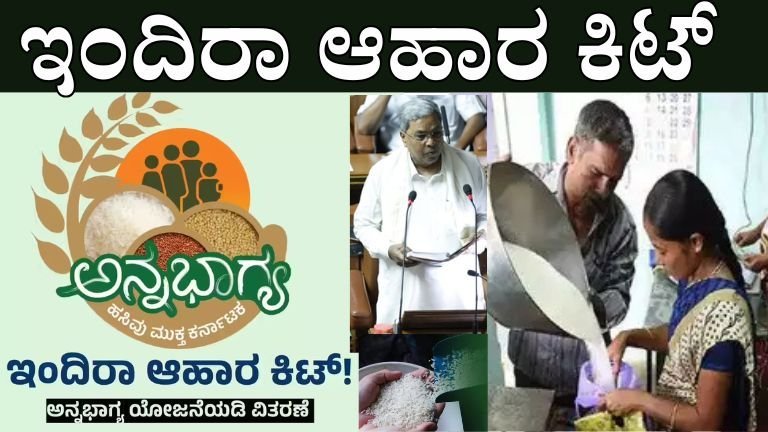🌾 Indira Food Kit Scheme in Karnataka: A 2025 Welfare Revolution for BPL Families
1. Policy Backdrop & Why It Matters
- Anna Bhagya Programme has long assured 10 kg of rice per month to ration-card families—5 kg from the central government and 5 kg from the state ([Deccan Herald](deccanherald.com)).
- However, routine surveys showed significant diversion of excess rice, with families either hoarding or selling surplus grains.
- As of June 2025, the Karnataka government plans a major pivot—offering nutritious food kits instead of the extra 5 kg rice. This is being branded as the “Indira Food Kit”, seeking approval in the July 2, 2025 Cabinet session .
2. What Exactly Is the Indira Food Kit?
The proposed kit replaces only the state’s 5 kg rice share—beneficiaries still receive 5 kg centrally supplied rice. Contents include:
- 2 kg wheat
- 1 kg toor dal
- 1 kg sugar
- 1 kg salt
- 1 litre cooking oil
- 100 g tea powder
- 50 g coffee powder
(prokannada.com)
Core idea: a well-rounded set of staples ensuring both caloric and micronutrient coverage.
3. Program Goals & Rationale
The Indira Food Kit targets multiple objectives:
- Improve Nutrition – Diversify from purely rice-based diets, lowering protein and micronutrient deficiencies (prokannada.com, prokannada.com).
- Prevent Misuse – Decrease rice diversion by offering lower-resale-value staples.
- Family Preferences – Surveys suggest 90%+ prefer diversified kits over rice-only packages (deccanherald.com).
- Fiscal Efficiency – Cost savings of ~₹720 crore/year are projected by replacing rice with cost-effective nutrient kits (prokannada.com).
4. Financial Analysis of the Scheme
- Estimated cost per kit: ₹400/month
- Annual liability: ₹6,144 crores vs ₹6,876 crores under rice-provisioning (+ central contribution) (prokannada.com)
- Net annual savings: ₹720 crores
These savings can be redirected to other social welfare priorities.
5. Eligibility & Beneficiary Profile
- Automatic inclusion via existing BPL/AAY ration cards registered in Karnataka (prokannada.com).
- No new registrations required; Aadhaar-seeded ration cards and bank accounts needed for streamlined delivery (prokannada.com).
This ensures minimal administrative hassle and maximum coverage.
6. Distribution Mechanism
- Delivery point: Existing Fair Price Shops (FPS) under PDS.
- Beneficiaries use Aadhaar-based biometric/OTP authentication to collect kits.
- Phased roll-out: Pilot in select districts post-Cabinet approval, followed by statewide expansion (prokannada.com).
Using existing infrastructure ensures cost-efficiency and familiarity.
7. Governance & Oversight
To uphold transparency:
- Branding with “Indira” & “Anna Bhagya” labels for visibility (prokannada.com).
- Procurement via Food Civil Supplies Department or approved agencies.
- Audits: Monthly internal plus third-party social audit mechanisms .
These checks aim to reduce leakage or adulteration risks.
8. Anticipated Impacts
- Public health: Improved protein & micronutrient intake among vulnerable BPL families.
- Economic justice: Reduced subsistence costs enhance disposable income.
- Trust-building: Citizen satisfaction rises with better kit composition.
- Fiscal reprioritization: ₹720 crores saved can support complementary schemes.
9. Expected Challenges
- Storage & logistics at FPS for varied items (pulses, oil).
- Leakage risk as new items have resale value.
- Quality control—purchases must meet safety norms.
- Communication gap—nationwide awareness campaigns needed.
- Rice entitlement assurance—ensuring that 5 kg of rice still reaches households.
10. Government Preparedness & Precedents
- Builds on Karnataka’s legacy with Indira Canteens—250 outlets in Bengaluru alone (indiatoday.in, prokannada.com, en.wikipedia.org, prokannada.com, thenewsminute.com).
- Digital tracking systems piloted via municipal platforms .
- Learning from success in other states like Kerala’s THR packages—they highlight importance of supply chain and oversight (niti.gov.in).
These precedents enhance rollout readiness.
11. Implementation Roadmap
| Phase | Activity | Timeline |
|---|---|---|
| Cabinet approval | Ministerial sanction | By July 2, 2025 |
| Procurement | Kit sourcing | July–August 2025 |
| Pilot rollout | Select districts test | Aug–Sept 2025 |
| Statewide rollout | Full implementation | Oct–Dec 2025 |
| Monitoring & audits | Quarterly evaluations | 2026 onward |
12. Public Feedback & Outreach
- Media campaigns via print and local radio.
- Panchayat-level messaging on kit contents and timing.
- Social audit booths at FPS locations for family feedback.
- Seva Sindhu portal updates with FAQs and implementation tracking.
13. Comparison With Other State Schemes
- Kerala: Nutrient-rich Take-Home Rations, strong on quality but storage-challenged (hindustantimes.com, prokannada.com, niti.gov.in).
- Tamil Nadu/Andhra: Canteen models (Amma, Indira) demonstrate cost-effective scale (en.wikipedia.org).
Karnataka’s hybrid approach (kit + strong monitoring) bridges gaps.
14. Political Significance & Branding
The name “Indira” resonates with welfare legacy (e.g., Indira Canteen, Indira Rasoi) .
It signals continuity in poverty-alleviation focus under the Siddaramaiah-led Congress administration.
15. Future Expansion Possibilities
- Add fortified salt, millets, fortified soya to kits.
- Integration with ICDS and health schemes for pregnant women and children.
- Digital monitoring with QR-coded packets, SMS alerts.
- Monthly tracking of nutritional impact through surveys.
Apply here: ✅ Apply Link ✅
Karnataka’s Indira Food Kit plan marks a major policy shift—building a nutrition-first welfare approach for BPL families, with strong fiscal prudence.
By phasing in kit distribution within existing PDS, backed by Aadhaar authentication, strong audits, and focus on diet diversity, it holds promise to be a model scheme.
Its success hinges on supply chain efficiency, oversight, timely communication, and maintaining core rice benefits. If done right, this model could influence nationwide welfare design.
